With the change in USDA's Plant Hardiness Zone Map, Salvia varieties once considered annuals are returning in Maryland gardens. These preferred plants for pollinators should be planted in a protected location in your yard if you wish to try to have them extend beyond the typical annual cycle. Salvia prefers full sun and well-draining soil. Wet soils can cause Salvia’s to perish.
Salvia greggii comes in various shades of pink, red, and fuchsia. All attract hummingbirds. These plants grow to 2-4 feet tall and wide and bloom all summer. They are woody and you should leave them over winter and prune when they break in spring.
Other Salvias, including the blue and purple varieties, attract hummingbirds with their tubular flowers. Pineapple sage is great to plant as it flowers late in the season offering nectar to the migrating hummingbirds on their return to South America. It develops bright red flowers in late September into October.
Cuphea ignea or Firecracker Plant with its orange-red tubular flowers is another plant that they seem to love. Cuphea will grow in the ground or in a pot. Deadhead for best flower production. It blooms all summer and does best with a bit of fertilizer if watered often.
plant that they seem to love. Cuphea will grow in the ground or in a pot. Deadhead for best flower production. It blooms all summer and does best with a bit of fertilizer if watered often.
Our native Lobelia cardinalis is one of the plants most visited in my yard. With all the recent rains this plant seems incredibly happy. Cardinal Flower can grow in full sun or part shade along streams and in moist areas. It grows 3-4 feet tall and develops a terminal bright red raceme in July into Sept. These plants live for 3-5 years and often re-seed.
Monarda especially the red varieties attract hummingbirds. Jacob Cline, a tall red variety does very well in the morning sun with protection from the hot midday sun. It can grow to four feet tall. There are other red varieties as well as deep pink, raspberry, and dark purple that attract hummingbirds. This plant is known as Bee Balm. I love the taller plants as it makes it easier to photograph hummingbirds.
Having a variety of plants for the hummingbirds that flower all summer into fall will make your yard a stopover as they migrate through your area.
Here is a good reference list for the plants that hummingbirds prefer the most.
Abutilon
- Annual with 150 species
- Bell-shaped flowers that bloom all summer into fall
- High sucrose content
Agastache

- Herbaceous perennial with 10 species
- Prefers well-drained organic soils and part to full sun
- Colors range from pastel apricot to blues and purples
- Blooms summer to fall
Aquilegia - Columbine

- Perennial with 60-70 species
- First flower frequented by hummers on return in spring
- Prefers part shade
Fuchsia 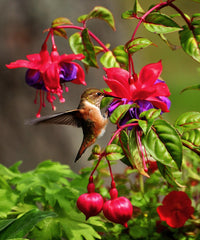
- Annual with over 100 species
- Prefers part shade
- Profuse blooms in containers
- Perennial in zone 10-11
- Prefers well-drained, rich soil and regular watering
- After flowering produces an edible fruit
Justica - Shrimp Plant
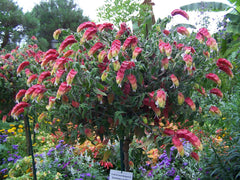
- Tropical loved by hummers that adds interest to any pot
- Native to Mexico, it is an evergreen shrub that should be brought indoors during the cold season
- Justica is a profuse bloomer
Kniphofia - Red Hot Poker
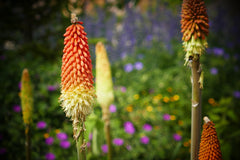
- 50 or more species
- Herbaceous perennial native to Africa
- Basal evergreen leaves
- Tall spiked flowers open over summer
- Colors from yellows to vivid red
Lobelia 
- Over 300 species from native cardinalis and siphlicata to annual varieties
- Native varieties prefer moist organic soils and full sun or part shade Cardinalis is a favorite and sought after in wild
Lonicera - Honeysuckle
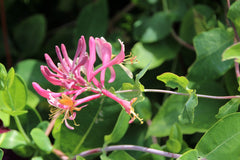
- Over 150 species but plant the native Lonicera sempervirens varieties
- Blooms late April thru fall and is loved by hummers due to very high fructose in nectar.
- Major Wheeler is a red-orange and John Clayton is bright yellow
Monarda - Bee Balm 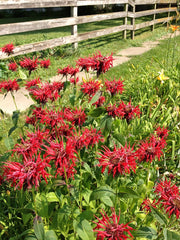
- Over 12 varieties available
- Red varieties like Jacob Kline and Fireball are favorites
- Native plant that prefers full to part sun and good air circulation to prevent powdery mildew
Penstemons - Beard’s Tongue
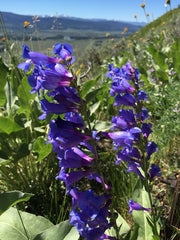
- Many species are native and have non-tubular flowers
with lip providing high sucrose - Native varieties include Husker’s Red or any Penstemon digitalis
Salvia
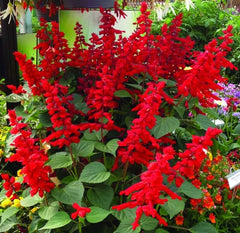
- One of the largest genus of plants that offer tubular flowers ranging from white to deep red to deep blue
- Perennial plants as well as annual varieties provide nectar to hummingbirds
- Annual types include Hot Lips, Black and Blue, Amistad etc
- Perennial types include Marcus, Blue Hill, Caradonna and Rose
Tecoma 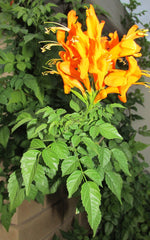
- Over 10 species of tropical vining bushes that offer very high sucrose
- Flowers are usually yellow or orange with red throats
Sage
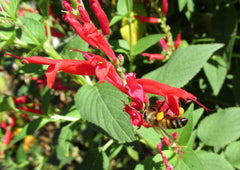
- Pineapple sage which blooms prolifically in late August through October is a great source of sucrose as hummingbirds migrate
-
This plant is a tender perennial
Others
Trumpet Vine
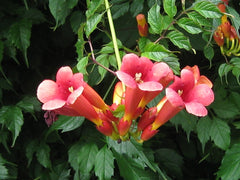
- Large trumpet-shaped flowers full of sucrose
- Flowers area a little large but they work
- Hummers pollinate as well as feed on Trumpet Vine flowers
Brugmansia
- Another tropical that provides large trumpet-shaped
flowers for feeding
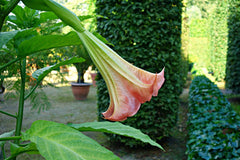
- Also fragrant and best used in planters.
Hummingbirds like tubular flowers as they hold more nectar that is rich in sucrose. Red is their favorite color as they can see it further away but any color will do. The shape of the flower and the amount of nectar dictates how many hummingbirds you attract. When plants are ready to be pollinated, the secretions of nectar increase. Nectar includes sucrose, glucose, and fructose. This process is repeated throughout the summer into fall as flowers are produced.
If you provide enough planted food sources then your hummingbirds will stop using your feeders. They also do not use feeders during nesting and hatching time as proteins are required for rearing young - they prefer spiders, gnats, and small insects.
Keep in mind that Hummingbirds feed insects to their young. For them to nest and remain in your garden, plant some of the following plants that harbor insects needed to raise young.
- Quercus alba
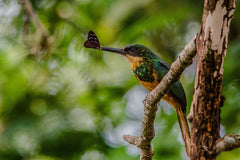
- Quercus phellos
- Quercus palustris
- Quercus rubra
- Quercus bicolor
- Prunus serotina
- Pinus strobus

- Acer rubrum
- Liriodendron tulipifera
Magnolia grandiflora, and other native trees, will harbor the insects they require, as well as nesting sites.










